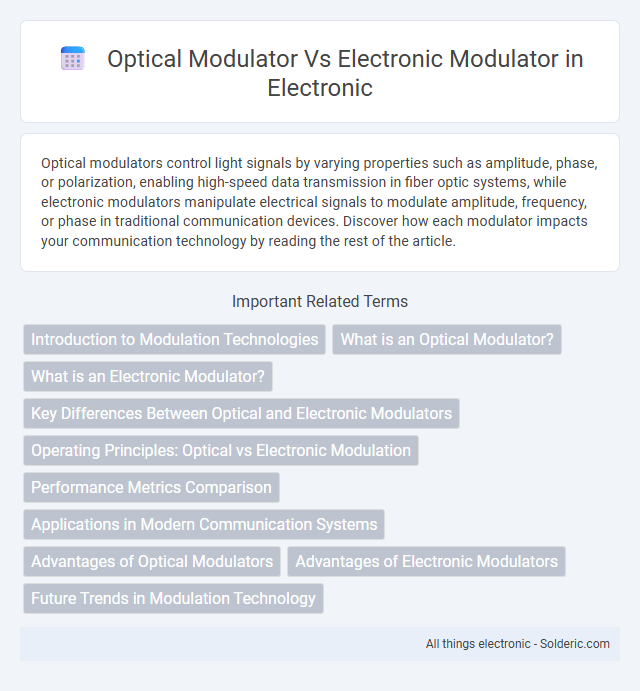Optical modulators control light signals by varying properties such as amplitude, phase, or polarization, enabling high-speed data transmission in fiber optic systems, while electronic modulators manipulate electrical signals to modulate amplitude, frequency, or phase in traditional communication devices. Discover how each modulator impacts your communication technology by reading the rest of the article.
Comparison Table
| Feature | Optical Modulator | Electronic Modulator |
|---|---|---|
| Modulation Medium | Light (optical signals) | Electrical signals |
| Speed | Very high (up to THz range) | Lower (MHz to GHz) |
| Bandwidth | Extremely wide bandwidth | Limited bandwidth |
| Applications | Fiber optic communications, LiDAR, optical computing | Radio transmission, audio/video signals, digital circuits |
| Complexity | More complex, needs optical components | Less complex, uses traditional electronics |
| Signal Loss | Lower over long distances | Higher over long distances |
| Power Consumption | Generally lower in high-speed systems | Varies, often higher in high-frequency circuits |
| Integration | Challenging, requires photonic integration | Easy with standard IC processes |
Introduction to Modulation Technologies
Optical modulators control light signals by varying properties such as amplitude, phase, or polarization, enabling high-speed data transmission in fiber optic communications. Electronic modulators manipulate electrical signals through voltage or current changes to encode information for various telecommunications applications. Understanding the differences between optical and electronic modulation technologies helps you select the optimal solution for efficient and high-bandwidth communication systems.
What is an Optical Modulator?
An optical modulator controls light properties such as amplitude, phase, or polarization to encode information in optical communication systems. Unlike electronic modulators that manipulate electrical signals, optical modulators directly modulate light beams, enabling higher bandwidth and faster data transmission. Your choice of an optical modulator enhances signal integrity and speeds in fiber-optic networks and photonic devices.
What is an Electronic Modulator?
An electronic modulator is a device that controls the amplitude, frequency, or phase of an electrical signal to convey information in communication systems. Unlike optical modulators that manipulate light waves for data transmission in fiber-optic networks, electronic modulators operate directly on electrical signals in radio frequency or baseband systems. They are essential components in AM, FM, and PM modulation techniques for radio, television, and digital communications.
Key Differences Between Optical and Electronic Modulators
Optical modulators manipulate light signals using variations in phase, amplitude, or polarization, leveraging materials like lithium niobate or silicon photonics for high-speed data transmission in fiber-optic communication. Electronic modulators, in contrast, control electrical signals by varying voltage or current to modulate amplitude, frequency, or phase in radio frequency and digital systems. Optical modulators offer broader bandwidth and lower signal attenuation, making them essential for ultrafast optical networks, while electronic modulators are more common in traditional electronic communication due to their ease of integration and cost efficiency.
Operating Principles: Optical vs Electronic Modulation
Optical modulators manipulate light properties such as intensity, phase, or polarization by using materials like lithium niobate or silicon photonics under the influence of an external optical or electrical signal. Electronic modulators alter electrical signals through voltage or current changes to encode data onto carrier waves, typically in RF or baseband frequencies. The fundamental distinction lies in optical modulators directly affecting photons for high-speed fiber optic communications, whereas electronic modulators process electron flow for electrical signal transmission.
Performance Metrics Comparison
Optical modulators offer higher bandwidth capabilities and faster response times compared to electronic modulators, making them ideal for high-speed communication systems. Electronic modulators typically exhibit lower insertion losses but are limited by electrical signal bandwidth and susceptibility to electromagnetic interference. Key performance metrics such as modulation speed, signal-to-noise ratio, and energy efficiency distinctly favor optical modulators in advanced photonic networks.
Applications in Modern Communication Systems
Optical modulators are essential in high-speed fiber optic communication networks, enabling data transmission at terabit-per-second rates with minimal signal loss and electromagnetic interference. Electronic modulators remain crucial for lower-frequency applications, such as radio frequency (RF) communication and signal processing in wireless systems, due to their ease of integration and cost-effectiveness. Your choice between optical and electronic modulators depends on the required bandwidth, data rate, and system design constraints in modern communication infrastructures.
Advantages of Optical Modulators
Optical modulators offer significant advantages over electronic modulators, including higher bandwidth and faster data transmission speeds due to their ability to operate at terahertz frequencies. They provide lower signal loss and minimal electromagnetic interference, enhancing signal integrity in high-speed communication systems. Your optical communication setup benefits from improved energy efficiency and the capability to handle vast amounts of data over long distances without degradation.
Advantages of Electronic Modulators
Electronic modulators offer faster response times and easier integration with digital circuits compared to optical modulators, making them ideal for high-speed communication systems. Their ability to operate at lower power consumption and cost-effectiveness enhances performance in electronic signal processing. You can achieve precise amplitude and frequency control, which is crucial for efficient data transmission in various applications.
Future Trends in Modulation Technology
Optical modulators leverage photonic integration and silicon photonics to deliver ultra-high-speed data transmission for next-generation communication networks, outperforming electronic modulators in bandwidth and energy efficiency. Emerging trends emphasize hybrid optoelectronic devices that combine electronic control with optical signal processing to enhance modulation speed and reduce latency. Advances in materials like graphene and integrated plasmonics are expected to revolutionize modulation technology by enabling compact, low-power, and broadband modulators for future 6G and beyond communication systems.
Optical modulator vs electronic modulator Infographic

 solderic.com
solderic.com